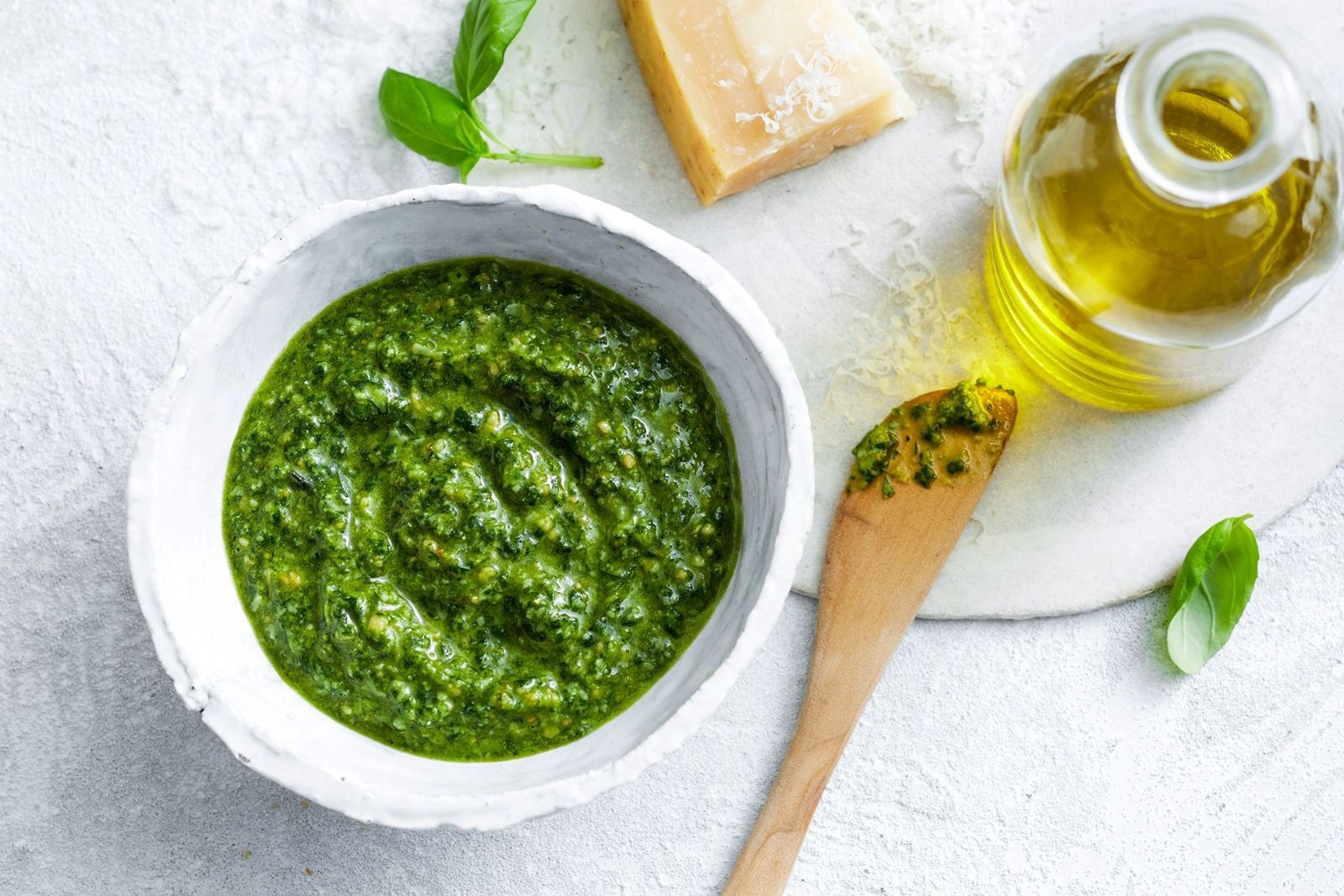
Pesto is a versatile and flavorful sauce made from fresh basil leaves, pine nuts, garlic, Parmesan cheese, and olive oil. It’s a staple in Italian cuisine and adds a burst of taste to various dishes, from pasta to sandwiches. While it’s delightful when made with fresh ingredients, there are times when you have an abundance of basil or a surplus of homemade pesto that you want to preserve for later use. Freezing pesto is an excellent way to extend its shelf life while maintaining its vibrant flavors. In this guide, we’ll walk you through the steps to freeze pesto successfully, so you can savor that delightful taste whenever you please.
Here’s a step-by-step guide on how to freeze pesto:
Step 1: Make or obtain fresh pesto
To begin the process of freezing pesto, the first and most crucial step is to ensure that you have a batch of fresh pesto on hand. This step lays the foundation for preserving the vibrant flavors and aromatic qualities that make pesto a beloved addition to various culinary creations. Here’s why the quality and freshness of your pesto matter:
- Homemade Pesto: If you’re making pesto from scratch, start by selecting the finest ingredients. Opt for fresh basil leaves that are vibrant green and free from wilting or yellowing. Use high-quality extra-virgin olive oil, as it contributes to both the taste and texture of the pesto. Freshly grated Parmesan cheese adds a rich and nutty flavor, while high-quality pine nuts provide a subtle crunch. Finally, fresh garlic cloves ensure that distinctive pungent kick that characterizes pesto. By using the best ingredients and preparing the pesto with care, you guarantee that the final product is bursting with flavor.
- Received Pesto: Sometimes, you may receive homemade pesto as a gift from a friend or purchase it from a local artisanal producer. In such cases, it’s equally important to verify the freshness and quality of the pesto you receive. Check for any signs of spoilage, such as mold or off-putting odors. If the pesto looks and smells fresh, it’s likely a suitable candidate for freezing. However, if there are any doubts about its condition, it’s best to err on the side of caution and refrain from freezing it.
The rationale behind using fresh pesto for freezing is straightforward: the better the pesto’s quality when it goes into the freezer, the better it will taste when you eventually use it in your recipes. Freezing can help extend the shelf life of your pesto, but it won’t miraculously improve its taste if it starts with subpar ingredients or if it’s already past its prime.
Step 2: Prepare your containers
Choosing the right containers for freezing your pesto is a pivotal step in the process. The containers you select should not only maintain the quality and flavor of the pesto but also make it convenient to portion and use when needed. Here’s a breakdown of why container selection and preparation are crucial:
- Container Types: There are several options for containers suitable for freezing pesto. Some of the most commonly used choices include:
- Glass Jars: Glass jars with airtight lids are an excellent option for larger quantities of pesto. They provide a secure seal and allow you to see the contents easily. Make sure the jars are designed for freezing to prevent breakage.
- Plastic Containers: Sturdy plastic containers with tight-fitting lids work well for freezing pesto. They are available in various sizes, making them versatile for portioning.
- Silicone Ice Cube Trays: These trays are ideal for smaller portions of pesto. Each compartment in the tray holds a small serving, making it easy to defrost just the amount you need for a specific recipe.
- Cleanliness and Dryness: Regardless of the container type you choose, cleanliness is paramount. Containers must be thoroughly cleaned and sanitized to prevent any residual flavors or odors from affecting your pesto. Ensure they are completely dry before filling them with pesto, as moisture can lead to freezer burn and compromise the quality of the sauce.
- Preventing Freezer Burn: Freezer burn occurs when air comes into contact with the surface of food, causing it to become dehydrated and develop unpleasant textures and flavors. Airtight containers or trays help create a barrier against air, safeguarding your pesto from freezer burn. Make sure the lids or covers fit securely to maintain the integrity of your pesto.
- Portioning: When selecting your containers, consider the portion sizes you’ll need for future recipes. Ice cube trays are great for small, single-use portions, while larger containers are suitable for larger quantities. Be mindful of your intended use so you can select the most appropriate container size.
Step 3: Portion the pesto
Portioning your pesto before freezing is a practical and strategic step that enhances the usability of your frozen sauce while minimizing waste. The choice of portion size depends on your cooking habits and preferences, but it’s a decision that can greatly affect the convenience and versatility of your frozen pesto. Here’s why portioning matters and how to go about it:
- Portion Size Considerations: When deciding on the portion size for your frozen pesto, consider how you typically use pesto in your recipes. Smaller portions are ideal for recipes that call for just a touch of pesto flavor, such as pasta dishes, sandwiches, or salad dressings. Larger portions work well for recipes that require a more significant quantity of pesto, such as pesto pizza or pesto-stuffed chicken breasts. By tailoring your portion sizes to your specific needs, you can avoid thawing more pesto than necessary.
- Using Ice Cube Trays: Ice cube trays are a popular choice for portioning pesto, especially for those who enjoy experimenting with different recipes. The small compartments in ice cube trays allow you to freeze individual servings, usually around one to two tablespoons each. This makes it incredibly convenient to take out only the amount of pesto you need for a particular dish without defrosting the entire batch. To fill the trays, use a spoon or small measuring cup to distribute the pesto evenly into each compartment.
- Larger Containers for Bigger Quantities: If you anticipate using larger quantities of pesto in your recipes, opt for larger containers instead of ice cube trays. These containers can hold several servings’ worth of pesto, making them suitable for dishes that require a substantial amount of sauce. Use a measuring cup to scoop and fill these containers, ensuring you have the right portion size for your intended recipes.
- Minimizing Waste: Portioning your pesto effectively helps minimize waste. When you have appropriately sized servings ready to go, you won’t need to defrost more pesto than you need, reducing the chances of leftovers going to waste. It also means you can enjoy the convenience of having pesto readily available for various culinary creations.
Step 4: Leave room for expansion
While preparing your pesto for freezing, it’s essential to account for the fact that liquids, including the olive oil in pesto, can expand as they freeze. This expansion can create pressure within the container, potentially causing leaks or compromising the seal. To avoid these issues and ensure a hassle-free freezing process, it’s crucial to leave some space at the top of the container to accommodate this expansion. Here’s why this step is essential:
- Preventing Container Damage: When liquids freeze, they expand and create pressure against the walls of the container. If the container is filled to the brim with pesto, this pressure can lead to the container cracking or breaking, especially if it’s made of glass or rigid plastic. By leaving some space at the top, you provide room for the expanding pesto, reducing the risk of container damage and the mess it can create in your freezer.
- Maintaining the Seal: Airtight containers are essential for preserving the quality of your pesto by preventing freezer burn and odors from affecting the sauce. If the container is overfilled, the expanding pesto can push against the lid or cover, compromising the seal. This can allow air to enter the container, potentially degrading the pesto’s quality over time. By leaving a small gap at the top, you ensure that the seal remains intact, safeguarding the pesto inside.
- Half an Inch Should Suffice: The ideal amount of space to leave at the top of your container is about half an inch (approximately 1.3 centimeters). This provides enough room for the pesto to expand without causing any issues with the container or seal. It’s a small but critical precaution to take to ensure that your frozen pesto retains its freshness and quality.
Step 5: Seal the containers
Once you’ve portioned your pesto into the chosen containers, the next critical step is to seal them effectively. Proper sealing is essential for preserving the quality and flavor of your pesto during its time in the freezer. The sealing method may vary depending on the type of container you use, whether it’s ice cube trays or larger storage containers. Here’s why sealing is crucial and how to do it correctly:
- Preserving Freshness: Airtight sealing is key to preserving the freshness and flavor of your pesto. It creates a barrier that prevents outside air from entering the container and freezer odors from affecting the sauce. This protection is vital because exposure to air and external odors can lead to flavor degradation and the development of freezer burn.
- Ice Cube Trays: If you’ve opted to portion your pesto into ice cube trays, sealing them effectively can be slightly different from using larger containers. Here are some methods to consider:
- Plastic Wrap: Cover the ice cube tray with plastic wrap, ensuring it’s tightly stretched over the top. Press it gently into each pesto-filled compartment to create a seal.
- Silicone Lid: Some ice cube trays come with silicone lids designed to fit snugly over the top. These lids provide an airtight seal and are convenient for sealing multiple portions at once.
- Larger Containers: For larger containers like glass jars or plastic containers, follow these steps to ensure a tight seal:
- Place the lid securely on the container, ensuring it fits properly.
- Double-check that the lid’s gasket (if applicable) is clean and in good condition. A damaged or dirty gasket can compromise the seal.
- Close any latches or clips on the lid, if present, to provide extra security.
- Press down firmly on the lid to remove any excess air inside before sealing it.
Step 6: Label and date
Labeling and dating your frozen pesto containers might seem like a minor detail, but it’s a critical step that can save you time, reduce waste, and ensure that your pesto remains in top condition. Here’s why this step is essential and how it benefits you:
- Avoiding Confusion: Frozen foods can all look quite similar once they’re frozen, making it challenging to distinguish between different batches or recipes. By labeling each container, you eliminate the risk of confusing your pesto with other sauces or ingredients in the freezer. This is especially crucial if you have a variety of frozen items and want to locate your pesto quickly.
- Tracking Freshness: The date of freezing serves as a valuable reference point for assessing the freshness of your pesto. Over time, even frozen foods can deteriorate in quality, and having the date on the container allows you to gauge whether your pesto is still at its peak. It helps you prioritize using older batches first to minimize food waste.
- Portion Control: If you’ve indicated the portion size on the label, it makes it even more convenient to grab the right amount of pesto for your recipes. Whether you’re planning to use a small cube for a sandwich or a larger portion for a pasta dish, the labeled containers provide clear guidance.
- Recipe Management: Suppose you have different variations of pesto, such as traditional basil pesto and sun-dried tomato pesto, stored in the freezer. Labeling ensures that you can easily identify which type of pesto is in each container, preventing any unexpected flavor combinations in your dishes.
- Rotation and Organization: Labeling containers with the date allows you to practice proper rotation of your frozen pesto. You can use the oldest batches first, ensuring that nothing goes to waste. It also aids in maintaining an organized freezer, as you can stack and store labeled containers efficiently.
- Emergency Planning: In case of power outages or freezer malfunctions, knowing the date of freezing can help you determine which containers are most crucial to use or discard, minimizing potential food safety concerns.
Step 7: Freeze
After meticulously preparing and sealing your pesto containers, it’s time to move forward and place them in the freezer. Freezing is the crucial step that preserves the freshness and flavor of your pesto for future use. Here’s why this step is essential and how to do it effectively:
- Preserving Freshness: Freezing is a method of preserving food by lowering its temperature to inhibit the growth of microorganisms that cause spoilage. In the case of pesto, freezing locks in the vibrant flavors of fresh basil, garlic, and cheese, ensuring that they remain intact until you’re ready to use the sauce in your recipes.
- Temperature Control: The freezer provides a controlled environment where the temperature is consistently below freezing. This low temperature prevents bacterial growth, enzymatic reactions, and other processes that can cause food to spoil or degrade. It’s this controlled cold that keeps your pesto safe and flavorful.
- Flat Surface Placement: When placing your pesto containers in the freezer, it’s crucial to ensure that they are on a flat surface. Placing them on a level shelf or rack helps prevent any accidental spillage or leakage during freezing. It also allows the containers to freeze evenly and maintain their shape, making it easier to stack and organize in your freezer.
- Minimizing Delay: It’s best to freeze your pesto as soon as possible after preparation. This ensures that the sauce goes into the freezer at its peak freshness, maximizing its quality when you eventually use it. Delaying the freezing process can lead to flavor degradation and potential loss of texture.
- Freezer Considerations: Keep in mind that your freezer should be set to a temperature of 0°F (-18°C) or lower to ensure the safe preservation of your pesto and other frozen foods. Make sure your freezer is in good working order, as temperature fluctuations or freezer malfunctions can affect the quality of frozen items.
- Uniformly Shaped Containers: If you’re using ice cube trays, make sure they sit flat and level in the freezer. This ensures that your pesto cubes freeze uniformly and can be easily popped out when needed.
How long can pesto last in the freezer?
Pesto can last in the freezer for up to 6-12 months when stored in airtight containers. Proper sealing and labeling are crucial to maintain its quality. Thawed pesto should be used promptly and not refrozen to prevent texture and flavor deterioration.
Step 8: Thaw and use
The final step in the process of freezing pesto is the thawing and usage stage. After all your careful preparation and freezing, it’s time to reap the rewards of having flavorful pesto readily available in your freezer. Here’s why this step is crucial and how to go about it effectively:
- Safe Thawing: Thawing is the process of returning frozen food to a safe and usable temperature. While frozen pesto is safe to eat straight from the freezer, thawing it properly ensures that it regains its desired consistency and flavors. Safe thawing is especially important when working with perishable ingredients like pesto, as it minimizes the risk of bacterial growth.
- Reaching Optimal Texture: When pesto is frozen, its texture can change due to the crystallization of water molecules. Thawing allows the sauce to regain its creamy and smooth texture, making it more suitable for use in various recipes.
- Thawing Methods: There are two primary methods for thawing frozen pesto:
- Refrigerator Thawing: This method is the safest and most recommended for pesto. Simply remove the desired portion from the freezer and place it in the refrigerator. Allow several hours, typically overnight, for the pesto to thaw completely. Thawing in the refrigerator is gradual and maintains the best quality and safety.
- Room Temperature Thawing: If you need to use the pesto more quickly, you can opt for room temperature thawing. Place the frozen container on the countertop, and the pesto will thaw more rapidly than in the refrigerator. This method is suitable when you need pesto within a few hours. However, it’s essential to keep a close eye on the pesto during this process to prevent it from becoming too warm, as this can lead to flavor degradation and potential food safety concerns.
- Using Thawed Pesto: Once your pesto has thawed to your desired consistency, you can use it just like freshly made pesto. Whether you’re stirring it into cooked pasta, spreading it on sandwiches, or incorporating it into various recipes, thawed pesto adds a burst of flavor to your dishes. It’s versatile and can elevate both simple and complex recipes.
- Prevent Refreezing: Avoid refreezing thawed pesto, as this can lead to changes in texture and flavor due to additional moisture loss. Instead, use all the thawed pesto within a reasonable timeframe, and enjoy its fresh taste.
Can I use frozen pesto in recipes without thawing it first?
Yes, you can use frozen pesto directly in recipes without thawing it first. In hot dishes like pasta, the heat from cooking will quickly melt and incorporate the frozen pesto. However, in cold dishes like salads, it’s best to thaw the pesto first for even distribution and a smoother texture.
Other related questions
Can I refreeze pesto?
It is not advisable to refreeze pesto once it has been thawed. Refreezing can lead to changes in texture and flavor due to additional moisture loss and potential bacterial growth. To maintain pesto’s quality, it’s best to use thawed pesto promptly and avoid refreezing.
How do I know if the pesto has gone bad after being frozen?
Signs of pesto going bad after freezing include off-putting odors, mold growth, or a noticeable change in color and texture. Freezer burn, indicated by ice crystals and a dry appearance, can also diminish quality. Properly stored pesto maintains its quality for an extended period, but any noticeable signs of spoilage should warrant discarding the sauce for safety.
Is it safe to freeze pesto with cheese, or should I add it later?
Freezing pesto with cheese is generally safe, but it may alter the texture of the cheese. Cheese can become slightly grainy or crumbly after freezing and thawing due to moisture changes. To preserve the cheese’s texture, consider adding it to your pesto when you’re ready to use the thawed sauce rather than freezing it together.
Can I freeze pesto with nuts like pine nuts or walnuts?
Freezing pesto with nuts like pine nuts or walnuts is possible, but the nuts may lose some of their crunchiness and texture when frozen. For optimal results, consider adding the nuts to the pesto when you’re ready to use the thawed sauce. This preserves the desired nut texture and ensures the pesto retains its best flavor and consistency.
Can I freeze pesto made with spinach or other greens besides basil?
Yes, you can freeze pesto made with various greens, but some may produce slightly different textures when frozen. It’s best to experiment and find what works best for your taste preferences.
How can I prevent my pesto from turning brown in the freezer?
To prevent pesto from turning brown in the freezer, follow these steps:
- Olive Oil Barrier: Before freezing, make sure your pesto is well-covered with a layer of high-quality olive oil. This layer acts as a protective barrier, shielding the pesto from oxygen exposure, which can cause browning.
- Remove Air: When filling your container, minimize air gaps to reduce the amount of oxygen in contact with the pesto. Pressing down on the pesto to remove excess air before sealing the container can help.
- Airtight Seal: Ensure your pesto container has airtight sealing to prevent any air from entering. This maintains an oxygen-free environment and preserves the vibrant green color.
- Label and Date: Properly label and date your pesto containers for easy identification and rotation. Use older batches first to maintain freshness.








